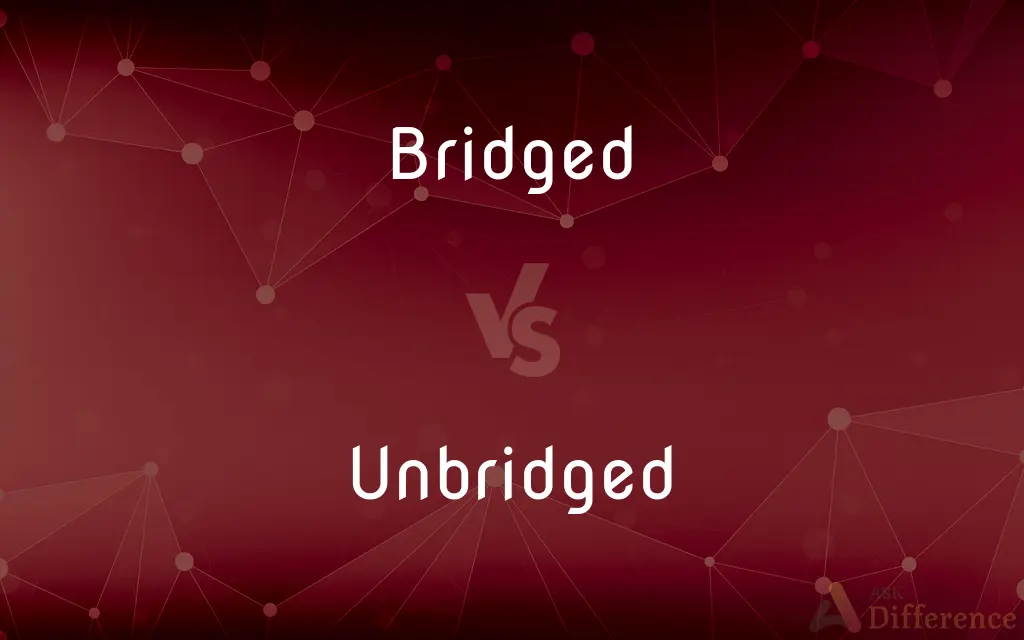Bridged vs. Unbridged — What's the Difference?
Edited by Tayyaba Rehman — By Urooj Arif — Updated on May 1, 2024
Bridged networks connect different network segments, enhancing communication and data flow, while unbridged networks lack these interconnections, potentially isolating segments.

Difference Between Bridged and Unbridged
Table of Contents
ADVERTISEMENT
Key Differences
Bridged networks utilize network devices, such as bridges, to connect and manage data traffic between two or more separate network segments, facilitating efficient communication and resource sharing. On the other hand, unbridged networks do not employ such devices, which can lead to isolated network segments that operate independently without direct data exchange.
Bridging helps in reducing network collisions and managing traffic effectively by segmenting data flows and isolating traffic within distinct segments, whereas unbridged setups may experience more collisions and network congestion due to the lack of such management.
While bridged networks are configured for performance optimization and scalability, allowing for larger and more complex network architectures, unbridged networks might be simpler and cost-effective but lack scalability and flexibility.
Bridged networks support advanced networking features like virtual LANs (VLANs) and network extension, enhancing the network’s functionality and security. In contrast, unbridged networks typically have basic setups and are less flexible in adapting to changing business needs or network expansion.
Comparison Chart
Network Devices
Uses bridges
Does not use bridges
ADVERTISEMENT
Data Flow
Efficient and managed
Potentially isolated and unmanaged
Scalability
High, supports complex networks
Limited, simpler networks
Performance
Optimized for fewer collisions
Prone to collisions and congestion
Features
Supports VLANs, network extension
Basic, lacks advanced features
Compare with Definitions
Bridged
Relates to enhancing connectivity between separate networks or network segments.
The IT manager suggested using a bridged approach to integrate the new office network.
Unbridged
Refers to a network setup without any bridging, often simpler and with limited connectivity options.
Unbridged networks are common in small businesses that don't require complex networking.
Bridged
Involving a device that connects two or more network segments at the data link layer.
Bridged connections are essential in large networks to prevent data collisions.
Unbridged
In audio, refers to not connecting amplifier channels together, each channel operates independently.
He preferred the unbridged setup for clearer sound quality in his audio system.
Bridged
In audio equipment, refers to connecting two amplifier channels to increase output power.
He bridged the amplifiers to achieve a more powerful sound system.
Unbridged
Lacking advanced features like VLANs and network extensions due to absence of network bridges.
Their network is unbridged, so expanding it would require significant restructuring.
Bridged
A network setup that uses bridging techniques to manage traffic and extend networks.
Bridged networks often use VLANs to manage large amounts of traffic.
Unbridged
Describes a basic or rudimentary network configuration, primarily used in small-scale environments.
The startup operates on an unbridged network due to limited resources.
Bridged
Pertaining to networks where segments are connected using network bridges to facilitate communication.
The company upgraded to a bridged network to improve data sharing between departments.
Unbridged
Pertaining to networks lacking bridge devices, resulting in separate and independent network segments.
Their home network is unbridged, with each floor acting as a separate segment.
Bridged
A structure spanning and providing passage over a gap or barrier, such as a river or roadway.
Unbridged
(of a river) That has not been bridged
Bridged
Something resembling or analogous to this structure in form or function
A land bridge between the continents.
A bridge of understanding between two countries.
Unbridged
(chemistry) Having no ligands bridging two centres
Bridged
The upper bony ridge of the human nose.
Bridged
The part of a pair of eyeglasses that rests against this ridge.
Bridged
A fixed or removable replacement for one or several but not all of the natural teeth, usually anchored at each end to a natural tooth.
Bridged
A thin, upright piece of wood in some stringed instruments that supports the strings above the soundboard.
Bridged
A transitional passage connecting two subjects or movements.
Bridged
(Nautical) A crosswise platform or enclosed area above the main deck of a ship from which the ship is controlled.
Bridged
A long stick with a notched plate at one end, used to steady the cue in billiards. Also called rest1.
Bridged
The hand used as a support to steady the cue.
Bridged
Any of various instruments for measuring or comparing the characteristics, such as impedance or inductance, of a conductor.
Bridged
An electrical shunt.
Bridged
(Chemistry) An intramolecular connection that spans atoms or groups of atoms.
Bridged
To build a bridge over.
Bridged
To cross by or as if by a bridge.
Bridged
Simple past tense and past participle of bridge
Bridged
Equipped with a bridge (in many contexts).
Common Curiosities
Can bridged networks reduce network congestion?
Yes, by segmenting network traffic and reducing data collisions, bridged networks help in managing congestion.
What is the main advantage of using a bridged network?
Bridged networks facilitate better communication and resource sharing across different network segments.
Are bridged networks more secure than unbridged networks?
Generally, yes, because they can implement more granular security policies across different segments.
What type of network is more suitable for large organizations?
Large organizations benefit more from bridged networks due to their efficiency and scalability.
What equipment is typically used in bridged networks?
Network bridges and sometimes switches with bridging capabilities are commonly used.
How do bridged and unbridged networks affect network scalability?
Bridged networks are more scalable and adaptable to growth, whereas unbridged networks may require significant changes for expansion.
Can an unbridged network setup be beneficial in any scenario?
Yes, for small, simple networks where complex data management and security are not critical, an unbridged setup can be cost-effective and sufficient.
What are the drawbacks of unbridged networks?
They tend to have isolated segments, which can limit communication and overall network performance.
Is setting up a bridged network more expensive than an unbridged network?
Initially, it can be due to the extra equipment and setup required, but it may offer cost savings through improved efficiency over time.
How do network bridges work?
They connect multiple network segments at the data link layer, managing and directing traffic between them based on MAC addresses.
Can bridging improve internet speed?
Not directly, but it can improve network efficiency, which might enhance overall performance.
Why might a business choose to remain unbridged?
Due to simplicity, cost constraints, or when the business does not require high network performance or scalability.
What is a VLAN and how does it relate to bridged networks?
VLAN is a virtual LAN that helps manage broadcast domains in a bridged network, enhancing performance and security.
How does bridging affect the physical layout of a network?
It doesn't change the physical layout but affects how data travels through the network by logically segmenting traffic.
What are some common scenarios where unbridged networks are used?
In home networks, small offices, or where separate segments do not need to communicate frequently or share resources.
Share Your Discovery

Previous Comparison
Result vs. Product
Next Comparison
Genocide vs. ExodusAuthor Spotlight
Written by
Urooj ArifUrooj is a skilled content writer at Ask Difference, known for her exceptional ability to simplify complex topics into engaging and informative content. With a passion for research and a flair for clear, concise writing, she consistently delivers articles that resonate with our diverse audience.
Edited by
Tayyaba RehmanTayyaba Rehman is a distinguished writer, currently serving as a primary contributor to askdifference.com. As a researcher in semantics and etymology, Tayyaba's passion for the complexity of languages and their distinctions has found a perfect home on the platform. Tayyaba delves into the intricacies of language, distinguishing between commonly confused words and phrases, thereby providing clarity for readers worldwide.
















































